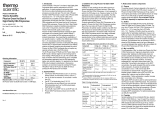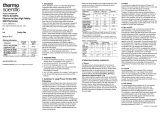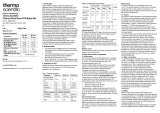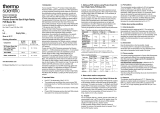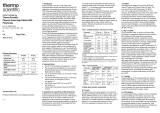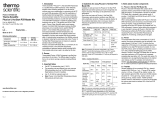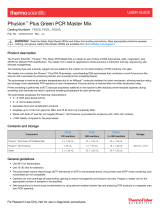Page is loading ...

PRODUCT INFORMATION
Thermo Scientific
Phusion Flash High-Fidelity
PCR Master Mix
Pub. No. MAN0012774
Rev. Date 27 June 2018 (Rev. B.00)
#__
Lot __ Expiry Date __
Store at -20°C
Ordering information
Component
#F-548S
100 rxns
#F-548L
500 rxns
2X Phusion Flash Master Mix
1 mL
5 1 mL
www.thermofisher.com
For Research Use Only. Not for use in diagnostic procedures.
1. Introduction
Thermo Scientific™ Phusion™ Flash High-Fidelity PCR
Master Mix is a 2X master mix based on modified
Phusion Hot Start II DNA Polymerase. The unique
composition of Phusion Flash High-Fidelity PCR Master
Mix enables the use of extremely short PCR protocols
(15 s/1 kb) with both low and high complexity DNA
templates. Phusion Flash PCR Master Mix contains all
the reagents required for PCR except for the DNA
template and primers.
Phusion Flash II DNA Polymerase is a proofreading
polymerase that contains a unique processivity-
enhancing domain, making this polymerase accurate and
rapid. Phusion Flash II DNA Polymerase is a hot start
polymerase utilizing a reversibly binding Affibody®
protein.1,2 This protein inhibits DNA polymerase activity at
ambient temperatures, thus preventing amplification of
non-specific products. In addition, the Affibody protein
blocks the 3’→5’ exonuclease activity of the polymerase,
preventing degradation of primers and template DNA
during reaction setup. At polymerization temperatures,
the Affibody protein dissociates from the polymerase
rendering the enzyme fully active.
Phusion Flash II DNA Polymerase possesses 5’→3’
DNA polymerase activity and 3’→5’ exonuclease activity.
The error rate using Phusion Flash PCR Master Mix is
9.5 10-7 when determined with a modified lacI-based
method.3 The error rate is approximately 25-fold lower
than that of Thermus aquaticus DNA polymerase and
3-fold lower than that of Pyrococcus furiosus DNA
polymerase. Phusion Flash DNA Polymerase is free of
contaminating endo- and exonucleases.The polymerase
is capable of amplifying long amplicons such as the
7.5 kb genomic and 20 kb lambda DNA used in Thermo
Scientific’s quality control assays.
2. Source
Thermostable Phusion DNA Polymerases are purified
from recombinant E.coli strains. The Affibody ligand is
purified from an E.coli strain carrying a plasmid encoding
Affibody protein.
3. Important Notes
Use 98 °C for denaturation (see 6.1 & 6.2).
The annealing rules are different from many common
DNA polymerases (such as Taq DNA polymerases).
Read Sections 5.2 and 6.3 carefully.
Use 15 s/kb for extension (see 6.4).
Note: Phusion Flash II DNA Polymerase produces
blunt end DNA products.
4. Guidelines for using Phusion Flash PCR
Master Mix
Carefully mix and spin down the Phusion Flash PCR
Master Mix tube before opening to ensure homogeneity
and improve recovery. The PCR setup can be performed
at room temperature.
Due to the nature of Phusion Flash II DNA Polymerase,
optimal reaction conditions may differ from other
amplification protocols. Please pay special attention to
the conditions listed below when running your reactions.
Following the guidelines will ensure optimal enzyme
performance.
Table 1. Pipetting instructions (add items in this order)
Component
20 µL rxn
50 µL rxn
Final conc.
H2O
Add to 20 µL
add to 50 µL
2X Phusion Flash
PCR Master Mix
10 µL
25 µL
1X
Primer A (see 5.2)
X µL
X µL
0.5 µM
Primer B (see 5.2)
X µL
X µL
0.5 µM
Template DNA
(see 5.3)
X µL
X μL
Table 2.Cycling instructions
Cycle step
2-step protocol
3-step protocol
Cycles
Temp.
Time
Temp.
Time
Initial
denaturation
98 °C
10 s
98 °C
10 s
1
Denaturation
(see 6.2)
Annealing
(see 6.3)
Extension
(see 6.4)
98 °C
-
72 °C
0 or 1 s
-
15 s/1 kb
98 °C
X °C
72 °C
0 or 1 s
5 s
15 s/1 kb
30
Final Extension
72 °C
4 °C
1 min
hold
72 °C
4 °C
1 min
hold
1
5. Notes about reaction components
5.1 Phusion Flash High-Fidelity PCR Master Mix
Phusion Flash PCR Master Mix contains all the
necessary reaction components for PCR except for
template DNA and primers. The composition of the
Phusion Flash PCR Master Mix is designed to give
optimal results.
When cloning fragments amplified with Phusion Flash II
DNA Polymerase, blunt end cloning is recommended. If
TA cloning is required, it can be performed by adding A
overhangs to the blunt PCR product with Taq DNA
Polymerase, for example. However, before adding the
overhangs it is very important to remove all Phusion
Flash II DNA Polymerase by purifying the PCR product
carefully. Any remaining Phusion Flash II DNA
Polymerase will degrade the A overhangs, creating blunt
ends again.
5.2 Primers
The recommendation for final primer concentration is
0.5 μM. If required, the primer concentration may be
optimized between 0.2-1.0 μM. To shorten the time
required for a PCR protocol, it is advisable to design
primers suitable for a two-step PCR protocol, if possible.
In a two-step PCR protocol, primer annealing and
extension occur at 72 °C and a separate annealing step
can be omitted. However, Phusion Flash PCR Master Mix
can also be used when performing a PCR protocol
with a separate annealing step (see section 6.3). The
results from primer Tm calculations can vary significantly
depending on the method used. Always use the Tm
calculator and instructions on website:
www.thermofisher.com/tmcalculator to determine the
Tm values of primers and optimal annealing
temperature.
5.3 Template
General guidelines for low complexity DNA (e.g. plasmid,
lambda or BAC DNA) are: 1 pg–10 ng per 20 μL reaction
volume, or 2.5 pg–25 ng per 50 μL reaction volume. For
high complexity genomic DNA, the amount of DNA
template should be 10–100 ng per 20 μL reaction
volume, or 25–250 ng per 50 μL reaction volume. If cDNA
synthesis reaction mixture is used directly as a source for
the template, the volume used should not exceed 10% of
the final PCR reaction volume.
(Continued on reverse page)

6. Notes about cycling conditions
6.1 Initial denaturation
Denaturation should be performed at 98 °C. Due to the
high thermostability of Phusion Flash II DNA Polymerase,
even higher temperatures may be used. Initial
denaturation of 10 seconds is recommended for all
templates when using Phusion Flash PCR Master Mix.
6.2 Denaturation
A very short denaturation step is recommended. For this
step, it is usually sufficient that the reaction mixture
reaches the required 98 °C. If the PCR instrument used
does not accept 0 seconds as a value, then a 1-second
value can be programmed.
6.3 Primer annealing
For minimizing the total PCR cycling time, a two-step
PCR protocol is recommended. It is applicable with
primers whose Tm values are, when calculated with our
Tm calculator (www.thermofisher.com/tmcalculator), at
least 69 °C or 72 °C (primers >20 nt or ≤20 nt,
respectively).
If necessary, use a temperature gradient to find the
optimal annealing temperature for each template-primer
pair combination. The annealing gradient should extend
up to the extension temperature (two-step PCR).
6.4 Extension
The extension should be performed at 72 °C. Extension
time of 15 seconds per 1 kb is suitable for most
templates. Some amplicons can be successfully amplified
with even shorter extension times, e.g. 1-5 seconds
per 1 kb.
7. Troubleshooting
No product at all or low yield
Repeat and make sure
that there are no pipetting
errors.
Make sure that the cycling
protocol was performed
as recommended.
Optimize annealing
temperature.
Titrate template amount.
Template DNA may be
damaged. Use carefully
purified template.
Increase the number of
cycles.
Check the purity and
concentration of the
primers.Check primer
design.
Check primer design.
Increase extension time.
Increase denaturation time
up to 5 seconds.
Non-specific products - High molecular weight smears
Make sure that the
extension time used was
not too long.
(Recommended extension
time is 15 s/kb).
Increase annealing
temperature or perform a
temperature gradient
PCR.
Titrate template amount.
Reduce the total number of
cycles.
Decrease primer
concentration.
Non-specific products - Low molecular weight discrete bands
Increase annealing
temperature.
Titrate template amount.
Shorten extension time.
Perform a temperature
gradient PCR.
Decrease primer
concentration.
Design new primers.
TECHNICAL SUPPORT
EMEA: ts.molbio.eu@thermofisher.com
Americas & APAC: ts.molbio@thermofisher.com
8. References
1. Nord K. et al. (1997) Nature Biotechnol. 15:
772–777.
2. Wikman M. et al. (2004) Protein Eng. Des. Sel. 17:
455–462.
3. Frey M. & Suppmann B. (1995) Biochemica 2:
34–35.
CERTIFICATE OF ANALYSIS
DNA amplification assay
Performance in PCR is tested by the amplification of a
7.5 kb fragment of genomic DNA and a 20 kb fragment of
lambda DNA.
Quality authorized by: Jurgita Zilinskiene
Important Licensing Information: This product may be covered by one
or more Limited Use Label Licenses. By use of this product, you accept
the terms and conditions of all applicable Limited Use Label Licenses.
PRODUCT USE LIMITATION
This product is developed, designed and sold exclusively for research
purposes and in vitro use only. The product was not tested for use in
diagnostics or for drug development, nor is it suitable for administration to
humans or animals. Please refer to www.thermofisher.com for Material
Safety Data Sheet of the product.
© 2018 Thermo Fisher Scientific, Inc. All rights reserved. All trademarks
are the property of Thermo Fisher Scientific Inc. and its subsidiaries.
/
